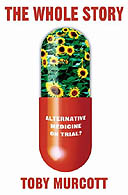
The Whole Story
by Toby Murcott
256pp, Macmillan, £16.99
As recently as the 1980s, people hardly dared mention to their doctor that they were seeking alternative therapy. Today, more than half of GPs recommend complementary medicine to their patients. However, there is only patchy evidence that most complementary medical systems actually work. Toby Murcott touches on some of it in this excellent overview of the subject. Even if he is somewhat parsimonious in what he includes, the fact remains that compared with the weight of proof behind a doctor's prescription for a particular drug, complementary medicine stands on decidedly shaky ground.
This might mean that millions of us are gullible fools, happy to pay handsomely for something about as efficacious as a Radox bath. A competing explanation, as Murcott discusses with admirable clarity, is that the methods by which medical science arbitrates on the effectiveness of healthcare interventions may be hopelessly inadequate. A basic but important point is funding: clinical trials are expensive, and across the health sector the pharmaceutical industry alone has had the financial clout to commission substantial volumes of research. Hence, we know most about drug treatments. The House of Lords inquiry into complementary medicine, for example, started a process of publicly funded research into non-orthodox treatments but methodology is a crucial concern.
Paralleling the 20-year rise of complementary therapies has been the emergence within orthodox practice of evidence-based medicine. Disciples of EBM worship at the altar of the randomised controlled trial (RCT). This has become the gold-standard by which medical interventions are assessed. The principles are deceptively simple: take a large group of people with the same problem, divide them up randomly to iron out biases, provide each subgroup with a different treatment and see which gives the best outcome. Performed properly, the RCT is a powerful tool for evaluating drugs, which are readily amenable to reductive analysis. There have been some positive results with complementary therapies - showing chiropractic to be effective for mechanical back pain, for example - but the majority of RCTs of alternative treatments have found no clear benefit.
It is likely that the RCTs conducted thus far have been insufficiently sophisticated properly to measure outcomes in complementary therapy. The reasons for this are long and arcane, and Murcott is to be congratulated for tackling the subject with clarity and fluency. The bottom line is that the paucity of evidence in favour of complementary therapies probably says more about naive research methodology than it does about the treatments under study.
For much of The Whole Story Murcott distances himself from questions of how a therapy such as acupuncture or homeopathy might work. The important questions - do they work? If so, for what? - are very far from settled. He cannot resist a little speculation, though. The emerging discipline of psychoneuroimmun- ology is beginning to describe the myriad ways in which the mind affects physiology and vice versa. We are starting to appreciate that the so-called placebo effect has a genuine biological basis: under the right conditions, people may quite literally heal themselves. Most complementary practitioners believe their therapy works by stimulating or enhancing this innate capacity for health. Intriguingly, science may one day prove them right. Even if not, Murcott summarises fascinating research which suggests that, irrespective of whether one is prescribing a homeopathic remedy or a hardcore pharmaceutical, the quality of the therapeutic relationship between practitioner and patient concretely influences the outcome. By far the most important conclusion in this book is that, in scrutinising the effectiveness of complementary therapies, orthodox medicine may be forced to rediscover the art of healing, something it lost sight of in the blinding explosion of scientific and technological progress of the past 50 years.
It is probably unwise to label any book as required reading. Nevertheless, when contemplating the entrenched attitudes of many in both the orthodox and complementary medical communities, the temptation to do so with The Whole Story is strong.
· Phil Whitaker is a writer, GP and director of a complementary medical centre.

